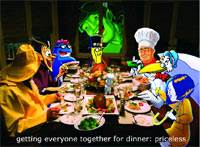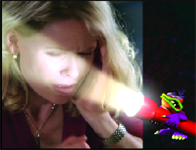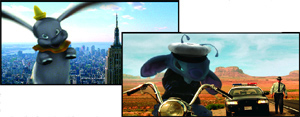MONSTER HEADACHE
"Character animation can add humor and fantasy to a spot to help it stand out from the other spots in the break," says Mark Medernach, executive producer for Duck Studios (www.duckstudios.com) in Los Angeles, a full-service animation company in business for over 30 years. "Since you're creating the character, you can make it do anything that you want, which is often more effective than adding effects to a live action actor."
Medernach says, "There's a growing trend of drug companies using 2D and 3D animated characters to convey the benefits of their drug products to the public." One such company is GlaxoSmithKline (GSK), which commissioned Duck Studios to create a comical, green 3D monster that represented a migraine headache to promote its headache-relief drug, Imitrex.
In the :30 spot, the viewer sees a live-action actress that is being given a migraine by an annoying monster. "The monster does cartoonish things to annoy the actress, like shining a flashlight in her face, banging on the screen with a mallet, turning on a drill, and even slapping the screen with a big, wet fish," says Medernach. The monster was created using Maya, with live-action compositing handled by Duck Studios 3D artist/animation director Lane Nakamura using Discreet Combustion.

Calabash Animation brought together an impressive group of animated icons for Debit MasterCard. Most were 3D but some, such as the Morton Salt Girl, were hand drawn.
|
SNUGGLE BEAR IN 3D
"Animated characters have a way of bringing personality to the screen, which, when done correctly, can be finessed and sharpened to be the perfect vessel for sales," explains Jeffrey Dates, creative director for Janimation (www.janimation.com/) in Dallas, which offers visual effects, design and animation for commercials and film. "If you have a good idea for a commercial that requires an animated character, then you're going to have a successful campaign.
"But if you're incorporating animated characters into your spot gratuitously, just because you want animated characters, then you may have to struggle to make it work," says Dates. "Animation is hard. Good animation is harder. So, knowing when to attempt it is the mark of a good campaign."
Janimation recently brought Snuggle - the famous bear mascot that represents Snuggle Fabric Softener - into the 3D world. "Traditionally, Snuggle Bear was realized by using puppets. So, taking him into the 3D world meant animating, styling and rendering CG fur - tons of it," says Dates, who was the lead animator. A big challenge associated with this project was the fact that Snuggle's appearance (like eye and mouth shapes) is strictly defined and these characteristics had to translate consistently into in 3D world, and throughout the character's performance.
Using Softimage|XSI, Mental Ray renderer, and Maya 3D and Paint Effects, Janimation's technical team animated Snuggle to skip through a storyboard forest, and everywhere he went, flowers would grow in his wake. Janimation's technical team included art director John McInnis, technical director Ludo Michaud, visual effects lead Lyn Caudle, 3D animation director Greg Punchatz, and animation producer Pete Herzog. Miami-based Accentmarketing (creative director Gary Bentz) produced this Snuggle spot, called Storybook, for Unilever.
"It's fun to work on a project where the animated character is immediately recognizable to viewers - like a star," says Dates. "Of course, since the audience already has expectations of what the star does and looks like, it's a challenge to meet and exceed their expectations."

Duck Studios used Maya and Combustion to create this headache-inducing monster for drug company GlaxoSmithKline.
|
TONY THE TIGER: MOVING ONE FRAME AT A TIME
"Today's flavor of character is smarter, sassier, more cynical, and even more stupid... than the more wholesome characters of 30 years ago," says David Daniels, director and partner of Bent Image Lab (www.bentimagelab.com/) in Portland, OR. "Low-budget, self-effacing, comedic characters are more dominant.
"We now see characters talking right at the camera as if they were doing off-the-cuff documentary dialogue, something unheard of 20 years ago," adds Daniels. "The animated pitchmen that work are self-reverentially comedic, like a pepperoni stick that sticks his head on a cheese grater and is headless for the rest of the spot. Or they're classic characters, like Tony the Tiger, who have been around for so long that they just work because they are culturally pervasive."
Introduced in the 1950s, the energetic, charismatic Tony the Tiger brand icon was recreated using stop-motion puppets for Kellogg's recent Tiger Power spot (Leo Burnett/Chicago) to promote the nutritional aspects of Frosted Flakes cereal. Tiger Power featured three vignettes of animal mothers - an orangutan, giraffe and ostrich - looking after their offspring. In the stop-motion spot, Tony the Tiger interviews them in a reality TV news style about their kid's diet. According to Daniels, the characters were a cross between Stuart Little realism and Wallace and Gromit simplicity.
"This was the first time Tony the Tiger had ever been done in 3D stop motion. As an animated character, he existed as cel animation and perhaps CG once or twice, but never as an object in the real photographic world, moving one frame at a time. I blended in a heavy amount of post production with my puppet characters giving them a more highly-produced, semi-realistic feel, never forgetting that great atmosphere is only there to support simple emotions and clean, distinct character personalities."
Tony was constructed of coils and paddles, and covered with a quarter-inch of clay, which allowed each section of his body to be individually manipulated in any manner, then the sculpting marks were painted out and blurred using filters. Bent Image Lab used Adobe After Effects for over six weeks, massaging every detail of every frame, rather than reserving all the finessing for a few rushed hours in a higher-end visual effects compositing box. Among the effects added to Tiger Power were volumetric lighting, lens flares, source lighting, rim highlights, haze and atmospheric details that Daniels says, "make it feel like it's a dewy morning on the jungle canopy or afternoon on the Serengeti."

For Disney's 50th Anniversary celebration, Digital Domain put classic 2D characters in the real world, thanks to 3D animation.
|
CHARACTER CONTROL
"Control is the most important thing animation brings to the table," says Ed Ulbrich, senior VP/GM for Digital Domain (www.d2.com/) in Venice, CA. "In an animated world, directors can execute their vision down to the smallest detail. Moments that are impossible or extremely difficult to capture in camera can be created in a computer for far less money than shooting on location.
"The directors and agency creatives who understand how enabling that kind of power is, are the ones blazing trails in commercial television. They are the ones who can most clearly execute their client's message," says Ulbrich.
For Disney's 50th Anniversary celebration, Digital Domain collaborated to create 3D versions of classic Disney characters and integrated them into the real world. The commercial, called Coming Home, was directed by Joe Pytka, and featured many of Disney's famed characters traveling from all around the world, with many of them crowding into a little car, so as not to miss the celebration.
"Remaining true to the original 2D characters was one of the challenges," says Ulbrich. "We had to settle on their height and size, and the texture of their skin, fur and feathers had to be established. But decisions also had to be made about how these characters would interact with their real-world environment. When you can literally do anything, the decision-making process can get difficult."
Last year, Digital Domain worked with director David Fincher on a Nike spot, titled Gamebreakers, which starred animated versions of professional football players like Michael Vick and Terrell Owens. "In it, the [virtual] camera makes impossible moves through an animated football game," says Ulbrich. Also, as snowflakes hit the lens, viewers are compelled to wonder if they are real or just an effect. Ulbrich adds, "In some ways, the players and environment look real, but in other ways, it is clearly animation."